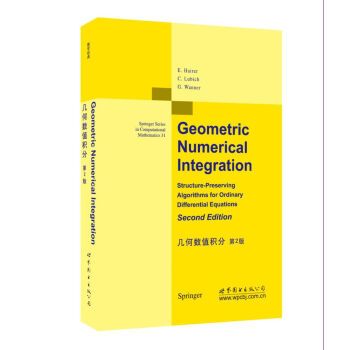內容簡介
《幾何數值積分》是一部教科書,旨在向大學3-4年級學生介紹哈密頓系統,可逆系統流型上的微分方程和高頻振盪解問題。書中全面論述了辛理論和對稱法。第2版主要增加了非典型哈密頓系統,高頻振盪機械系統和多步法動力學。本書各章有習題。讀者對象:數學等相關專業的大學高年級本科書和低年研究生。
目錄
I.Examples and Numerical Experiments
I.1 First Problems and Methods
I.1.1 The Lotka-Volterra Model
I.1.2 First Numerical Methods
I.1.3 The Pendulum as a Hamiltonian System
I.1.4 The St6rmer-Verlet Scheme
I.2 The Kepler Problem and the Outer Solar System
I.2.1 Angular Momentum and Kepler's Second Law
I.2.2 Exact Integration of the Kepler Problem
I.2.3 Numerical Integration of the Kepler Problem
I.2.4 The Outer Solar System
I.3 The Henon-Heiles Model
I.4 Molecular Dynamics
I.5 Highly Oscillatory Problems
I.5.1 A Fermi-Pasta-Ulam Problem
I.5.2 Application of Classical Integrators
I.6 Exercises
II.Numerical Integrators
II.1 Runge-Kutta and Collocation Methods
II.1.1 Runge-Kutta Methods
II.1.2 Collocation Methods
II.1.3 Gauss and Lobatto Collocation
II.1.4 Discontinuous Collocation Methods
II.2 Partitioned Runge-Kutta Methods
II.2.1 Definition and First Examples
II.2.2 Lobatto IIIA-IIIB Pairs
II.2.3 Nystr6m Methods
II.3 The Adjoint of a Method
II.4 Composition Methods
II.5 Splitting Methods
II.6 Exercises
III.Order Conditions, Trees and B-Series
III.1 Runge-Kutta Order Conditions and B-Series
III.1.1 Derivation of the Order Conditions
III.1.2 B-Series
III.1.3 Composition of Methods
III.1.4 Composition of B-Series
III.l.5 The Butcher Group
III.2 Order Conditions for Partitioned Runge-Kutta Methods
III.2.1 Bi-Coloured Trees and P-Series
III.2.2 Order Conditions for Partitioned Runge-Kutta Methods
III.2.3 Order Conditions for Nystrom Methods
III.3 Order Conditions for Composition Methods
III.3.1 Introduction
III.3.2 The General Case
III.3.3 Reduction of the Order Conditions
III.3.4 Order Conditions for Splitting Methods
III.4 The Baker-Campbell-Hausdorff Formula
III.4.1 Derivative of the Exponential and Its Inverse
III.4.2 The BCH Formula
II1.5 Order Conditions via the BCH Formula
1II.5.1 Calculus of Lie Derivatives
III.5.2 Lie Brackets and Commutativity
III.5.3 Splitting Methods
II1.5.4 Composition Methods
III.6 Exercises
IV.Conservation of First Integrals and Methods on Manifolds
IV.1 Examples of First Integrals
IV.2 Quadratic Invariants
IV.2.1 Runge-Kutta Methods
IV.2.2 Partitioned Runge-Kutta Methods
IV.2.3 Nystrom Methods
IV.3 Polynomial Invariants
IV.3.1 The Determinant as a First Integral
IV.3.2 Isospectral Flows
IV.4 Projection Methods
IV.5 Numerical Methods Based on Local Coordinates
IV.5.1 Manifolds and the Tangent Space
IV.5.2 Differential Equations on Manifolds
IV.5.3 Numerical Integrators on Manifolds
IV.6 Differential Equations on Lie Groups
1V.7 Methods Based on the Magnus Series Expansion
IV.8 Lie Group Methods
IV.8.1 Crouch-Grossman Methods
IV.8.2 Munthe-Kaas Methods
IV.8.3 Further Coordinate Mappings
IV.9 Geometric Numerical Integration Meets Geometric Numerical Linear Algebra
IV.9.1 Numerical Integration on the Stiefel Manifold
IV.9.2 Differential Equations on the Grassmann Manifold
IV.9.3 Dynamical Low-Rank Approximation
IV.10 Exercises
V.Symmetric Integration and Reversibility
VI.Symplectic Integration of Hamiltonian Systems
VII.Non-Canonical Hamiitonian Systems
VIII.Structure-Preserving Implementation
IX.Backward Error Analysis and Structure Preservation
X.Hamiltonian Perturbation Theory and Symplectic Integrators
XI.Reversible Perturbation Theory and Symmetric Integrators
XII.Dissivativeiv Perturbed Hamiltonian and Reversible Systems
XIII.Oscillatory Differential Equations with Constant High Frequencies
XIV.Oscillatory Differential Equations with Varying High Frequencies
XV.Dynamics of Multistep Methods
Bibliography
Index

